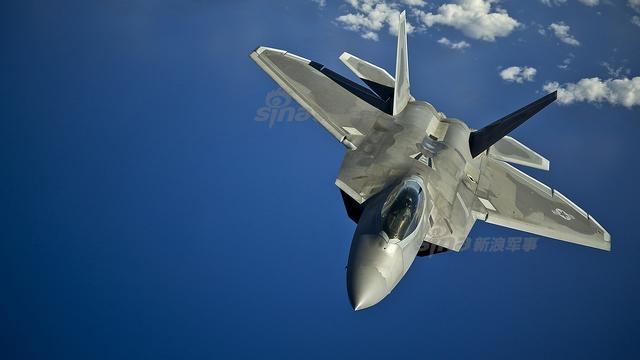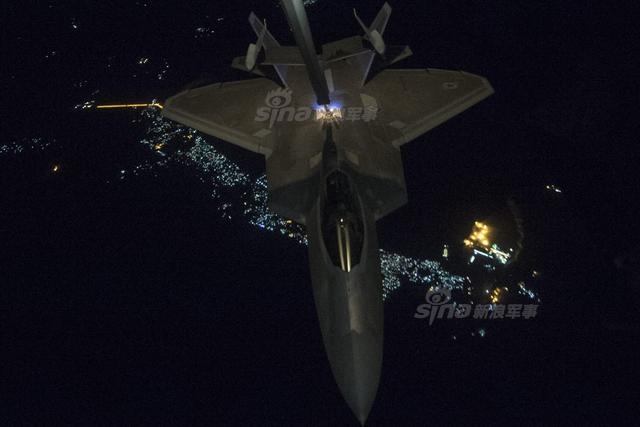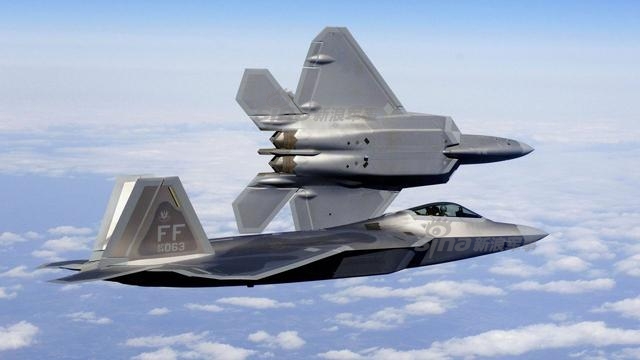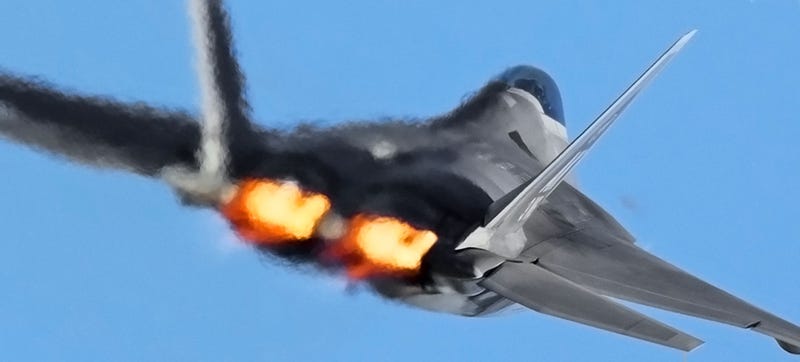Russian & American had been playing games in Syria over F-22 F-35 Su-35 etc.
https://www.defensetech.org/2017/06/27/f-22-raptor-didnt-get-air-air-kill-syria/
Why the F-22 Raptor Didn’t Get the Air-to-Air Kill in Syria
TOPICS:
air forceF-22Global Hot SpotsISISLockheed MartinRaptor
U.S. Air Force Maj. Dan “Rock” Dickinson, F-22 Raptor Demonstration Team commander and pilot, performs during the OC Air Show at Ocean City, Md., June 17, 2017. (U.S. Air Force photo/Kimberly Nagle)
Posted By:
Oriana Pawlyk June 27, 2017
SOUTHWEST ASIA — U.S. fourth-generation fighter jets this month scored some historic air-to-air kills in Syria.
On June 18, a Navy
F/A-18E Super Hornet conducted the U.S. military’s first air-to-air kill involving a manned aircraft in nearly two decades when it downed a hostile Su-22 Fitter south of Taqbah. On June 8 and again on June 20, Air Force
F-15E Strike Eagles shot down Iranian-made Shaheed drones over At Tanf as the unmanned aerial vehicles approached or dropped munitions near U.S.-backed forces on the ground.
But aviation geeks, or “AvGeeks,” couldn’t help but wonder why the most advanced fifth-generation air-to-air fighter — the Air Force’s
F-22A Raptor made by Lockheed Martin Corp. — was missing from the action.
So this reporter posed that question to Brig. Gen. Charles Corcoran, commander of the 380th Expeditionary Wing, which houses the F-22s for Operation Inherent Resolve, the Pentagon’s name for the anti-ISIS campaign.
Related content:
Sitting down for an interview at his office at a base here in an undisclosed location, Corcoran explained that while F-22s are indeed forward
deployed, there is a limited number of the aircraft in theater and they’re not always circling over the warzone given the distances between the locations.
“We put the F-22s in the highest-threat areas as much as we can, but they can’t be there 24/7,” Corcoran told Military.com on Monday.
“When these occurrences took place,” he said, referring to the pro-Syrian regime aircraft threatening U.S.-backed forces in recent weeks, “the [aircraft] that were there were F-18s and F-15s.”
Corcoran, himself a Raptor pilot, mentioned that a
KC-10 airman asked him, “
heard you guys are mad at the F-15E guys” for getting the kill.
“Really, who told you that?” Corcoran recalled responding.
The KC-10 airman replied, “The F-15E guys.”
Corcoran said he reassured him, “No, nobody’s sad about not getting a kill. We’re happy that everyone’s doing their job.”
https://southfront.org/american-f-22-raptor-fighter-jets-lose-anti-radar-coating-in-syria/
American F-22 Raptor Fighter Jets Lose Anti-Radar Coating in Syria
The US F-22 Raptor fighter jets, which are used by the US Air Force in Syria, have started to lose its radar-absorbing coating.
The F-22 Raptor fifth-generation tactical fighter aircraft (Photo: Reuters)
The US F-22 Raptor fighter jets, participating in a military operation in Syria, have started to lose coating, hiding them from radars, the Aviation Week news portal reported.
The radar-absorbing coating on bodies of the aircraft warped and started to peel off. According to the US Air Force, climatic conditions in the area of usage of the warplanes are one of the reasons of this trouble.
According to head of the F-22 program of Lockheed Martin, John Cottam, the coating wrinkles and peels off due to the fact that it loses its hardness and turns into its original liquid state. He also noted that this process is accelerated by external factors, including rain and sand dust.
Earlier, US pilots complained about destruction of radar-absorbing coating during contact with fuel and lubricating oil. In 2009, a former engineer of the Lockheed Martin, Olsen Derrol, accused the company of application several excessive layers of the radar-absorbing coating in order to hide the fact that the ‘invisible’ coating easily erased from a body of fighter jets under influence of water, oil and fuel.
Developers of the F-22 Raptor claim that they have created a new, more stable formulation and are going to use it on all the 186 produced fighter jets during maintenance operations. According to preliminary estimates, this process will take at least three years.
Tags:F-22, F-22 Raptor, Lockheed Martin, syria, Syrian War, us, US AIR FORCE, usa
https://foxtrotalpha.jalopnik.com/the-f-22-raptor-finally-bloodies-its-talons-in-attack-o-1637984159
Jalopnik

The F-22 Raptor Bloodies Its Talons In First Attack Over Syria

Tyler Rogoway
9/24/14 10:28am
Filed to: Raptors
220.7K
27344
The world's only operational 5th generation stealth fighter has waded into combat for the first time in its almost decade old career with the USAF. Ironically, an aircraft that was built to be the ultimate air-to-air fighter went to war for the first time slinging bombs. Regardless of its mission, the first combat use of the F-22 has been tragically long overdue.
Although it has had its teething problems, F-22 is a highly misunderstood machine whose procurement and continued development has been guided as much by politics as by strategic wisdom and vision. It remains the most deadly fighter aircraft ever flown, and in many ways it will remain overall the most capable fighter in the world even after the younger F-35 enters service in the coming years.

We Finally Know Why An F-35 Burned On The Runway
We are finally getting information as to what caused the F-35A engine fire that has left the entire …
Read more
The Raptor's continued development has seen the jet transform from strictly an air superiority fighter, aimed at knocking down anything that dares to oppose its dominion over the sky, to an air supremacy fighter that can not only swat down advanced fighters and bombers but can also deliver a deadly blow to an enemy's integrated air defense system (IADS) and fixed targets of strategic value. In addition, the F-22's unrivaled avionics suite can work as a mini RC-135 ELINT aircraft, AWACS, Electronic Attack aircraft and its radar 'imagery' can provide intelligence gathering and targeting for other vastly disparate weapon systems, such as the US Navy's sea and submarine launched BGM-109 Tomahawk missiles.
Half master key and half battering ram, the F-22 has become a weapon system that can give combatant commanders the most valuable gifts of all: access and information. For years it has been denied a chance to prove this incredible value in combat, but with the actions taken over Syria on the night of September 23rd, 2014, that has finally and thankfully changed.
The Raptor Is Finally Uncaged, Strikes At The Heart Of ISIS In Syria:
F-22s, of which a handful have been continuously deployed to an air base in the UAE since around the turn of the decade, most likely led the initial attacks on targets in and around Raqqa, Syria, ISIS's self proclaimed capital of their Islamic State. Each Raptor is capable of streaking into Syria near invisibly at close to 60,000 feet, while supercruising at speeds up to mach 1.7, to hit four separate targets with up to eight Small Diameter Bombs from over fifty miles away from their launch point. Alternatively, the F-22 can attack two larger strategic targets with a pair of 1,000 JDAMs from 15 miles away. This enhanced ground attack capability was part of the F-22's 'increment 3.1 software upgrade,' along with improved mapping and ground targeting capabilities, as well as being able to initiate electronic attacks using its powerful APG-77 AESA radar.
This test footage shows the F-22 launched SDB in action:
It is said that the White House did not want to engage Assad's forces during this initial attack, which left striking Syrian air defense units off the table unless they tried to engage coalition fighters. Some 47 BGM-109 Tomahawks were fired at targets from the Red Sea and Arabian Sea, putting no pilot's lives at risk. All counted, the Pentagon says 200 weapons were fired and four dozen aircraft were used in the attacks against 22 separate targets. Regardless of what you may have heard on cable news, this opening series of strikes, although substantial, are not equivalent to the opening air attacks carried out in past major air campaign operations, but they are a start.
F-22's attack on a large ISIS compound:
The F-22 may very well have been alone in the fight when it comes to its missions deep inside Syrian territory, seeing as its unique radar evading and speed of action capabilities would not have offered Syrian air defenses ample time to engage, or even see them at all. Other less advanced American fighter and bomber aircraft were said to have been used on the raids as will, including F-16CMs in the precision strike and Wild Weasel role apparently:
As it sits now, it seems that a handful of aircraft were employed by the majority of Arab partner nations taking part in the strikes, with four Jordanian F-16MLU Vipers, four Saudi F-15S Eagles, four UAE F-16E/F Block 60 Vipers, and two F-16C Vipers from Bahrain doing the actual shooting alongside their US counterparts. It is rumored that Qatar's Mirage 2000s also took part in the attacks but in a non air-to-ground role.
There are some reports that a secret back-channel agreement exists between the US and the rickety Assad government in Damascus that would allow these air strikes to take place without interference. If this is true, than the use of Tomahawks, F-22s, and F-16s packing AGM-88 HARMS is very puzzling. It is quite possible that such an arrangement does exist but confidence in it was not high. Thus precautions were taken should Syria's air defenses have come online during the raids. Additionally, the F-22's targets may have been of extremely high priority, and fears that some in the Syrian armed forces or government would have tipped off the target to an incoming attack would have justified the use of a very stealthy delivery platform, in this case the F-22.
The Raptor Has Been Caged Up Under False Pretenses For Far Too Long
Infrared imagery that was most likely taken by unmanned aircraft, along with still satellite photos posted by the Defense Department, show the results of F-22's strikes in Syria. These are proof of the very first hard return on investment (although this is close) the Raptor has been allowed to give back to a mostly non-appreciative government.
Setup Timeout Error: Setup took longer than 30 seconds to complete.
The F-22 was held back from taking part during the Operation Odyssey Dawn, America's involvement in the air war over Libya in 2011. The reasoning behind the Raptor's absence was that supposedly the jet could not share tactical information via data link with NATO's less capable fighter aircraft. This justification for not employing the Raptor over Libya, which was a hot defense subject at the time as the F-22 production line was controversially closing with just a measly 187 aircraft built, was based on a half truth and carefully crafted shaping of the public's understanding of how the Raptor could be employed during such a conflict.
In actuality, F-22 could have been integrated into a larger coalition air campaign using a flying digital gateway and data communications fusion center, known as the Battlefield Airborne Communications Node (BACN).
Akin to a flying universal translator of sorts, this system, flown on the EQ-4 Global Hawk, the Global Express business jet based E-11A and NASA's WB-57s, take's the F-22's stealthy data link transmissions, originally designed to share information only with other F-22s, and re-translates them into a common Link16/MIDS waveform. It then fuses this information with many other platforms' sensor data and rebroadcasts this fused sensor 'picture' to all coalition aircraft equipped with a Link16/MIDS data terminal. Targeting data, picture and text messaging and greatly enhanced situation awareness (where the good guys and the bad guys are) are all provided by Link16, especially when a facilitator gateway like BACN is in the air providing an 'active net' over the whole battlefield.

Why The USAF's Massive $10 Billion Global Hawk UAV Is Worth The Money
The Global Hawk has been flying for close to 15 years, and its development has been a twisting road …
Read more
BACN's 'active net' covers the battlefield from the ground up and over great distances in a manner that pales in comparison to a non-gateway enabled, platform-to-platform based "daisy-chained" data link communications architecture. BACN's ability to provide beyond line-of-sight, data-fused connectivity for aircraft, ground forces, ships and other weapons systems is said to be nothing less than revolutionary.
Some would argue (including your author) that the F-22 is so capable that it does not necessarily need other coalition aircraft's help during the early stages of a conflict beyond supporting surveillance, tanking, and in some cases, jamming capabilities. The Raptor's ability to operate over hostile territory while remaining relatively undetected, and jam or electronically attack enemy anti-aircraft emitters and dispose of aerial threats with relative impunity if need be, means that it can go about its war fighting without having to necessarily destroy the enemy's entire air defense network first.
Taking out an enemy's air defense network is something that traditionally takes weeks or longer to achieve, even against a comparatively rudimentary foe. Only after the enemy's air defense capabilities have been shattered could traditional air power strictly focus on hitting targets that actually deflate an enemy's ability to wage war. The F-22, with its incredibly sensitive electromagnetic listening and radio-signal geo-locating ability via its ALR-94 electronic support measures (ESM) suite, can avoid these air defenses all together, or locate and destroy them with haste, all at distances that are great enough to allow the jet to remain undetected. Additionally, it can do this while also providing the most capable anti-air capability the world has ever seen.
What all this adds up to is the fact that even though America's Raptors may not fit seamlessly into an integrated coalition air campaign without a BACN enabler, in some cases their exotic abilities make such a coalition force less than optimal tactically. The F-22's blistering performance, sensor fusion and stealth capabilities create something of a paradox where involving less capable fighter aircraft in a limited air campaign over a limited geographical area could complicate and thus hinder the F-22's combat effectiveness by simply getting in its way. So, although constructing a diverse coalition of air power may be politically prudent, in certain cases it would just slow the F-22 down. Additionally, piecing together such a diplomatic puzzle gives the enemy ample time to adapt and prepare for air strikes, thus greatly lessening their effects on the battlefield.
It may sound a little cliche, but the F-22 Raptor may have been hurt by the fact that it is too good at its job, and its workplace was never intended to be a highly diverse one. So by holding the jet back based on the fact that it does not communicate well with its co-workers is not entirely fair considering that it really does not need much help getting the job done in the first place.
This is precisely why the Raptors should have been used during the opening stages of the Libyan air campaign as it could have shortened the duration of that war. This is something that in retrospect would have been valuable as the power vacuum would not have existed for such a long period of time as the country slipped deeper and deeper into chaos. I suspect this could have amounted to less foreign fighters and extremist influences being brought into the fray, and there would have been less time for rebel militias to become battle hardened and organized along sectarian and tribal lines.
In the end, the country suffered for many weeks while America was coalition building, during which time the F-22 could have been at work creating a no-fly-zone, hitting strategic targets, and taking down Qaddafi's air defenses if required. The results of our failed policies in Libya were made abundantly clear recently when the US Embassy in Tripoli was abandoned.

U.S. Quietly Evacuates Libyan Embassy With Surprise Convoy Escape
With Tripoli's major airport coming under fire and a civil war raging in the streets,…
Read more
I wrote the following on April 10, 2011:
The Obama Administration missed a golden opportunity to send in our 70 BILLION dollar (total program cost) F-22 into an environment in which no other aircraft could have flourished similarly. In fact, as anti-Qaddafi forces were knocking on Tripoli's door, the American people were being sold a now archaic picture of what it would take to impose a No Fly Zone over the troubled North African nation. From day one, Secretary Gates painted an elaborate picture of what it would take to execute such a mission, with no mention of the F-22's unique capabilities. He talked about a massive air to ground campaign (something that is a BIG turnoff to war-weary American citizens), including the extensive destruction of enemy air defenses (DEAD), command nodes, and aviation facilities. Where was the super stealthy, super-cruising, 60k feet high-flying, electronic intelligence gathering, radar jamming F-22 in this grand picture? Nowhere.
The reality is that we could have deployed F-22 squadrons to that theater, which would have been able to operate ALONE over Libya, shooting down any hostile targets that may pop up with certain efficiency, only relying on only AWACS and tanker support. Keep in mind, it could do this WITHOUT having to extensively attacking Libya's archaic air defenses in order to safely operate above the country. If certain pinpoint attacks on command and control or air defenses installations were indeed called for, the F-22 could accomplish this utilizing GPS guided munitions and small diameter bombs at a fraction of the cost of TLAM (Tomahawk) cruise missiles fired off of US Navy surface combatants and submarines.
In the end, the Obama Administration waited well over a month to put together a colorful coalition of varying air combat abilities, with a prized UN resolution in hand. Politically this may have been a great thing, but we have now spent our treasure and put our image once again at risk in the region. All the while, the last-minute response in support of a demoralized and weakened rebel force has given way to a civil war in stalemate. With America abruptly fading from the picture after a sizable and expensive cruise missile and close air support offensive, leaving in its place a less capable and weak coalition, who's only tools (medium altitude precision bombing) are becoming less effective as the enemy has adapted and is exploiting the coalition's inability to bomb in urban areas due to their total lack of forward air controllers on the ground.
The Raptor's time had finally come, presented with a perfect scenario for it to do a job that no other aircraft in the world could have done, alone and in its element. Instead, we traded the advantage of engaging in battle at the time of our choosing and with a force that is most likely to obtain victory, for vague political cover.
Since operations began without the F-22 in theater, excuses have been made by different departments about how the Raptor's data link was insufficient to operate with other MIDS/LINK16 equipped aircraft from other nations, this is true, BUT this would not have mattered if the F-22 was sent to do the job alone and in a timely matter in the first place. I would dare to say that if the Raptor was given the chance to shut down Qaddafi's air force at the peak of the rebel's advance, the mission of regime change in Libya would have already been accomplished.
Has the Raptor become America's Bald Eagle at the zoo? An awesome creature to observe but one that will never be allowed to leave the cage by its heavy handed and often special-interest compromised care takers?
This same scenario played out to an even greater degree in Syria, where a more brutal conflict was erupting that was almost sure to devolve into one where WMD would be used against the Syrian people and extremist elements would begin to metastasize in what was becoming an almost total power vacuum across large swathes of that country. Fast forward through nearly four years of fighting and the power vacuum that expanded during these years, along with gas attacks on civilians, hundreds of thousands of lives lost and the rise of a terrorist army that spans from nearly the Mediterranean to the Persian Gulf, and it hard to argue against the idea that doing something to weaken Assad early on would have been very prudent.
This is where the F-22 would have once again been the perfect tool with which America could have set up a no fly zone over Syria early on. Beyond setting up a no fly zone, if need be, the F-22's mission could have been flexed to strike regime and military targets with haste. This would all be possible without a costly and risky protracted air campaign aimed at dismantling Syria's air defense network by a vulnerable international hodgepodge of 4th generation fighters. Such a strategy would have once again been largely a "go-it-alone" F-22 one, at least at first, but it would have been very cost efficient and time effective, while also offering minimal risk to American lives.
When it comes to Libya and Syria, the American people were sold a bag of questionable excuses by those in Washington as to why the Raptor was kept on the sidelines, saying that a no-fly-zone in both countries would have had to include a costly and dangerous multi-national air campaign to completely wipe out all air defenses before other targets could be struck. This was really an archaic vision of aerial warfare, one in which the F-22, a program that the Obama administration prematurely cancelled (the Bush Administration punted the issue into in 2008 in cowardly fashion) seemingly did not exist. In other words, the 'Raptor Option" was strangely either thrown out on superficial grounds or never even presented.
I voiced these concerns in a large piece that weighed the positive and negative aspects of setting up a no fly zone over Syria dating back to August 27th, 2012. Now, years after a no-fly-zone and a limited air campaign against Assad's regime were floated, debated and staunchly knocked down by the Obama Administration, the F-22 has arrived on the battlefield, seemingly to great effect.
We can now only wonder what things would be like if the F-22 was employed early on as a low risk concept for denying Assad's continued and brutal use of air power against his own people and moderate free Syrian rebels. In addition, if the US had air supremacy over Syria years ago, our surveillance information and reconnaissance aircraft could have been operating at will over that country and would have better observed ISIS's rocketing rise to power. Then again, maybe Assad would already be out of power and ISIS would never have had the ridiculously fertile breeding ground in which it rapidly expanded its military reach, geographic control and wealth in the first place.












